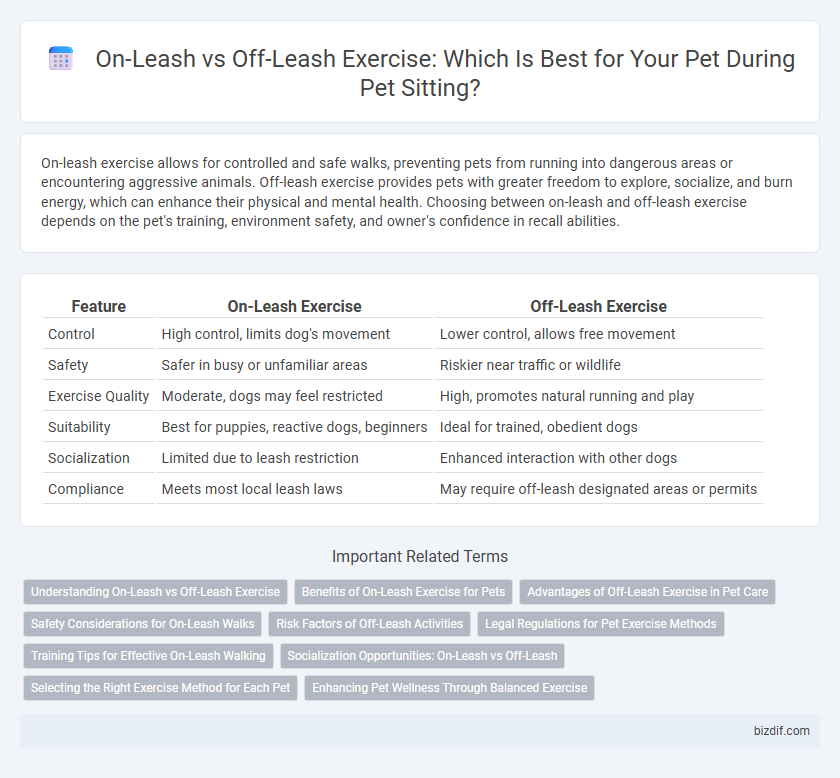On-leash exercise allows for controlled and safe walks, preventing pets from running into dangerous areas or encountering aggressive animals. Off-leash exercise provides pets with greater freedom to explore, socialize, and burn energy, which can enhance their physical and mental health. Choosing between on-leash and off-leash exercise depends on the pet's training, environment safety, and owner's confidence in recall abilities.
Table of Comparison
| Feature | On-Leash Exercise | Off-Leash Exercise |
|---|---|---|
| Control | High control, limits dog's movement | Lower control, allows free movement |
| Safety | Safer in busy or unfamiliar areas | Riskier near traffic or wildlife |
| Exercise Quality | Moderate, dogs may feel restricted | High, promotes natural running and play |
| Suitability | Best for puppies, reactive dogs, beginners | Ideal for trained, obedient dogs |
| Socialization | Limited due to leash restriction | Enhanced interaction with other dogs |
| Compliance | Meets most local leash laws | May require off-leash designated areas or permits |
Understanding On-Leash vs Off-Leash Exercise
On-leash exercise ensures controlled and safe walks, preventing pets from running into danger or causing disruptions, essential in urban or crowded areas. Off-leash exercise allows dogs more freedom to roam, providing mental stimulation and physical activity crucial for high-energy breeds and socialization. Understanding the balance between on-leash restraint and off-leash freedom optimizes pet well-being and safety during outdoor activities.
Benefits of On-Leash Exercise for Pets
On-leash exercise provides pets with controlled physical activity that ensures safety in busy or unfamiliar environments, reducing risks of accidents and encounters with aggressive animals. It allows owners to maintain close supervision, promoting obedience and reinforcing training commands during walks. This structured interaction improves socialization skills and helps manage pets' behavior more effectively in public spaces.
Advantages of Off-Leash Exercise in Pet Care
Off-leash exercise allows pets to engage in natural behaviors, promoting mental stimulation and physical health by enabling free movement and exploration. It enhances muscle development and cardiovascular fitness as dogs run, jump, and play without restriction, reducing stress and anxiety levels. Off-leash time also improves socialization skills and obedience when supervised properly, contributing to overall well-being in pet care.
Safety Considerations for On-Leash Walks
On-leash exercise provides enhanced safety for pets by allowing owners to maintain control, preventing encounters with aggressive animals or hazardous environments. Leashes reduce the risk of pets running into traffic or getting lost, ensuring a secure and manageable walk. Proper leash length and harness fitting are critical to avoid strain or injury during walks.
Risk Factors of Off-Leash Activities
Off-leash exercise allows pets greater freedom and natural movement but comes with increased risks such as potential encounters with aggressive animals, exposure to hazardous terrain, and the possibility of running into traffic or getting lost. Lack of leash control can lead to unpredictable behavior in unfamiliar environments, increasing the chance of injury or conflict with other dogs and humans. Ensuring secure, fenced areas and close supervision are critical to mitigate these off-leash risk factors during pet sitting.
Legal Regulations for Pet Exercise Methods
Legal regulations for pet exercise methods vary significantly by location, with many municipalities requiring dogs to be on-leash in public areas to ensure safety and control. Off-leash exercise is often restricted to designated dog parks or private properties where local laws permit free roaming under owner supervision. Pet sitters must be aware of these regulations to avoid fines and ensure compliance while providing safe and enjoyable exercise for pets.
Training Tips for Effective On-Leash Walking
Effective on-leash walking requires consistent training to reinforce basic commands such as "heel," "sit," and "stay," ensuring the dog remains focused and controlled during walks. Using positive reinforcement techniques like treats and praise encourages desirable behaviors, while avoiding pulling or lagging behind. Short, regular training sessions combined with proper leash handling tools, such as harnesses or front-clip leashes, enhance communication and safety for both pet and owner.
Socialization Opportunities: On-Leash vs Off-Leash
On-leash exercise provides controlled socialization opportunities, allowing pets to interact safely with other animals and people under close supervision, which is ideal for shy or reactive dogs. Off-leash exercise promotes natural social behaviors and more dynamic group play, enabling dogs to develop stronger social skills in an open environment. Balancing on-leash and off-leash activities helps enhance a pet's overall socialization, reducing anxiety and improving obedience during interactions.
Selecting the Right Exercise Method for Each Pet
Selecting the right exercise method for each pet depends on factors such as breed, temperament, and training level. On-leash exercise provides control and safety in urban or high-traffic areas, preventing pets from running into danger. Off-leash exercise suits well-trained dogs with strong recall skills, allowing them to engage in more natural behaviors and burn off energy effectively in secure, enclosed spaces.
Enhancing Pet Wellness Through Balanced Exercise
On-leash exercise ensures controlled physical activity that enhances pet safety while building endurance and obedience through structured movement. Off-leash exercise promotes mental stimulation and freedom, encouraging natural behaviors that contribute to overall pet wellness. Combining both on-leash and off-leash activities delivers balanced exercise, improving cardiovascular health, reducing anxiety, and supporting a pet's holistic well-being.
On-leash exercise vs Off-leash exercise Infographic

 bizdif.com
bizdif.com